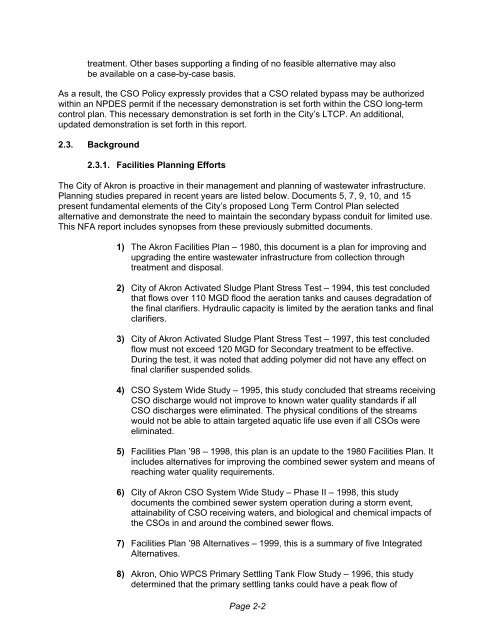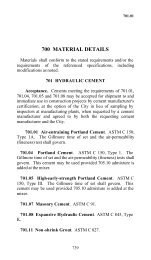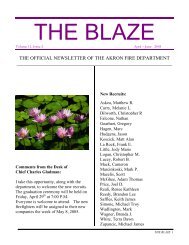Akron Water Pollution Control Station No Feasible Alternative
Akron Water Pollution Control Station No Feasible Alternative
Akron Water Pollution Control Station No Feasible Alternative
You also want an ePaper? Increase the reach of your titles
YUMPU automatically turns print PDFs into web optimized ePapers that Google loves.
treatment. Other bases supporting a finding of no feasible alternative may also<br />
be available on a case-by-case basis.<br />
As a result, the CSO Policy expressly provides that a CSO related bypass may be authorized<br />
within an NPDES permit if the necessary demonstration is set forth within the CSO long-term<br />
control plan. This necessary demonstration is set forth in the City’s LTCP. An additional,<br />
updated demonstration is set forth in this report.<br />
2.3. Background<br />
2.3.1. Facilities Planning Efforts<br />
The City of <strong>Akron</strong> is proactive in their management and planning of wastewater infrastructure.<br />
Planning studies prepared in recent years are listed below. Documents 5, 7, 9, 10, and 15<br />
present fundamental elements of the City’s proposed Long Term <strong>Control</strong> Plan selected<br />
alternative and demonstrate the need to maintain the secondary bypass conduit for limited use.<br />
This NFA report includes synopses from these previously submitted documents.<br />
1) The <strong>Akron</strong> Facilities Plan – 1980, this document is a plan for improving and<br />
upgrading the entire wastewater infrastructure from collection through<br />
treatment and disposal.<br />
2) City of <strong>Akron</strong> Activated Sludge Plant Stress Test – 1994, this test concluded<br />
that flows over 110 MGD flood the aeration tanks and causes degradation of<br />
the final clarifiers. Hydraulic capacity is limited by the aeration tanks and final<br />
clarifiers.<br />
3) City of <strong>Akron</strong> Activated Sludge Plant Stress Test – 1997, this test concluded<br />
flow must not exceed 120 MGD for Secondary treatment to be effective.<br />
During the test, it was noted that adding polymer did not have any effect on<br />
final clarifier suspended solids.<br />
4) CSO System Wide Study – 1995, this study concluded that streams receiving<br />
CSO discharge would not improve to known water quality standards if all<br />
CSO discharges were eliminated. The physical conditions of the streams<br />
would not be able to attain targeted aquatic life use even if all CSOs were<br />
eliminated.<br />
5) Facilities Plan ’98 – 1998, this plan is an update to the 1980 Facilities Plan. It<br />
includes alternatives for improving the combined sewer system and means of<br />
reaching water quality requirements.<br />
6) City of <strong>Akron</strong> CSO System Wide Study – Phase II – 1998, this study<br />
documents the combined sewer system operation during a storm event,<br />
attainability of CSO receiving waters, and biological and chemical impacts of<br />
the CSOs in and around the combined sewer flows.<br />
7) Facilities Plan ’98 <strong>Alternative</strong>s – 1999, this is a summary of five Integrated<br />
<strong>Alternative</strong>s.<br />
8) <strong>Akron</strong>, Ohio WPCS Primary Settling Tank Flow Study – 1996, this study<br />
determined that the primary settling tanks could have a peak flow of<br />
Page 2-2







